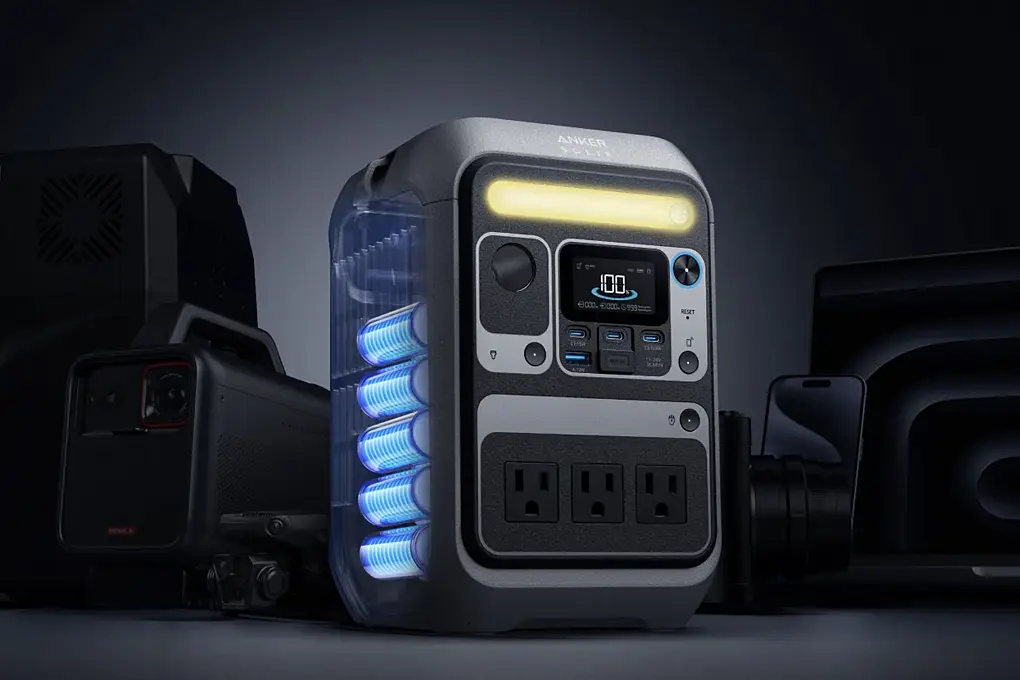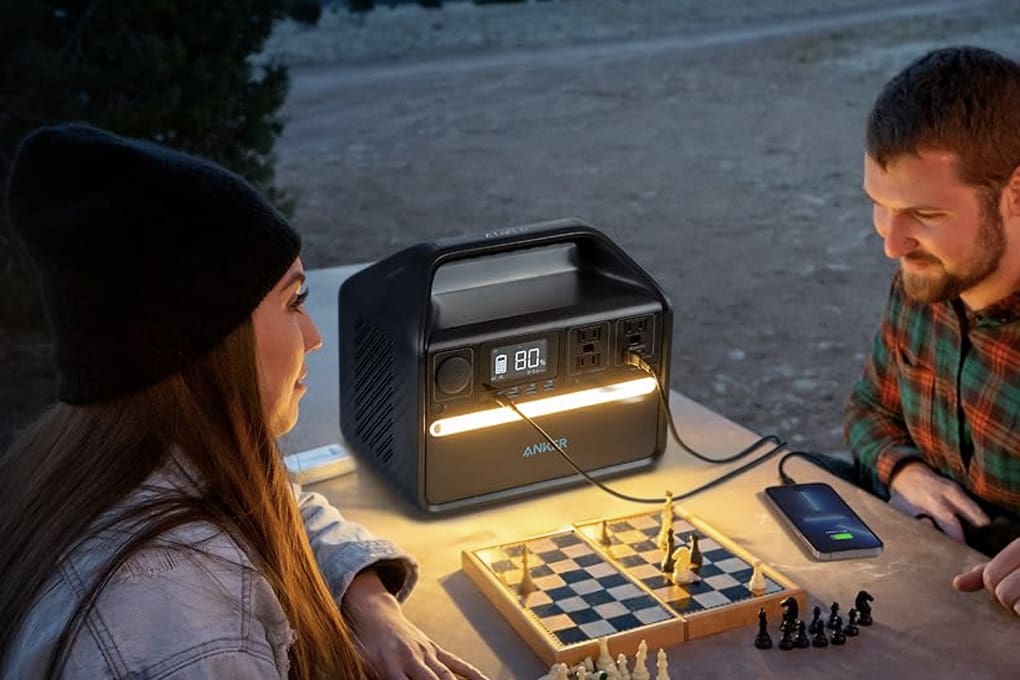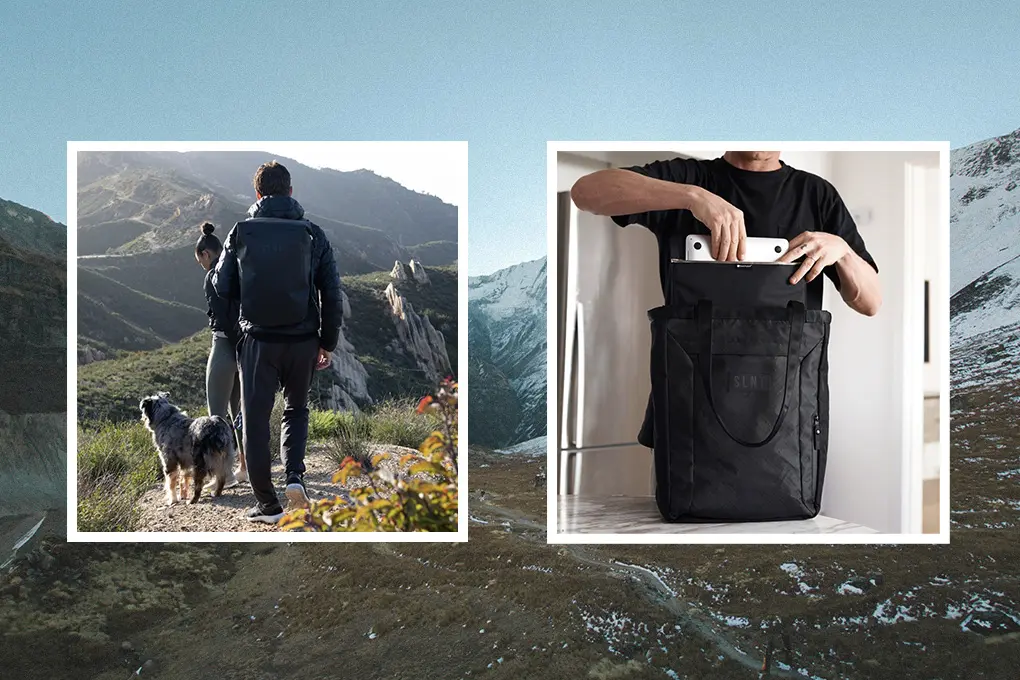Quick Answer: The Anker SOLIX C300X is a compact, fast-charging portable power station designed for families preparing for outages or off-grid situations. With 288Wh capacity, a LiFePO₄ battery rated for 3,000 cycles, and solar compatibility, it reliably powers essential devices during emergencies while remaining easy to use, portable, and durable.
If you think power outages are rare inconveniences, think again. According to the U.S. Census Bureau’s 2023 American Housing Survey, roughly one in four U.S. households (33.9 million) experienced at least one outage in the previous 12 months. And these aren’t quick blips – 70% of affected households said at least one outage lasted six hours or more.
National outage patterns are getting worse. The U.S. Energy Information Administration reports the average American customer faced 5.6 hours without power in 2022, with states like Louisiana suffering more than 24 hours of outages annually, nearly four times the national average.
Major storms are a big part of the problem. Hurricane Ian (2022) cut power to 2.6 million Florida customers, while the 2021 Texas winter storm left 10 million people in the dark, some for over three days, racking up as much as $130 billion in economic damage. The indirect costs are even higher – researchers found that over 70% of blackout-related economic losses come from “resilience tactics” like emergency lodging or running generators.
For families, the fallout is personal. A 6-hour outage can spoil food and refrigerated medicine; longer blackouts leave phones dead, medical devices offline, and work or school disrupted. With severe weather intensifying and grid reliability lagging behind, backup power is a necessity.
That’s where the Anker SOLIX C300X comes in, offering a compact, user-friendly solution to keep the essentials running when the grid goes down.
Table of Contents
- Key Takeaways
- How We Tested the Anker SOLIX C300X
- Technical Specifications
- Performance Analysis
- User Experience and Interface
- Emergency Preparedness Applications
- Solar Integration and Off-Grid Performance
- Long-Term Reliability and Value
- Pain Points and Limitations
- What Users Are Actually Saying
- Who Should Buy the Anker SOLIX C300X
- Competitive Analysis
- Bottom Line on the Anker SOLIX C300X
- Frequently Asked Questions
- Sources
Key Takeaways
- The Anker SOLIX C300X is a 288Wh portable power station that balances performance, portability, and ease of use for family emergency preparedness.
- Our 30-day testing showed 86% battery efficiency, strong solar charging between 65W and 78W, and fast AC recharge to 80% in about 50 minutes.
- Its lightweight 9.1-pound design, quiet 25dB operation, and built-in LED light make it practical during outages and evacuations.
- The LiFePO₄ battery lasts up to 3,000 cycles, and the five-year warranty exceeds typical coverage, supporting long-term reliability.
- Solar integration works well with Anker’s 100W panel, though cloudy conditions slow charging and the XT60 connector limits third-party panel compatibility.
- Limitations include modest capacity for larger families, a 300W output cap, and additional costs for accessories like solar and car charging cables.
- Visit Batten Emergency to find expert-vetted preparedness solutions that complement backup power systems for full family protection.
How We Tested the Anker SOLIX C300X
We spent 30 days putting the Anker SOLIX C300X through a structured series of real-world and lab-based tests to understand how it performs under pressure. Our goal was simple: to find out if this power station can deliver reliable backup power when families truly need it.
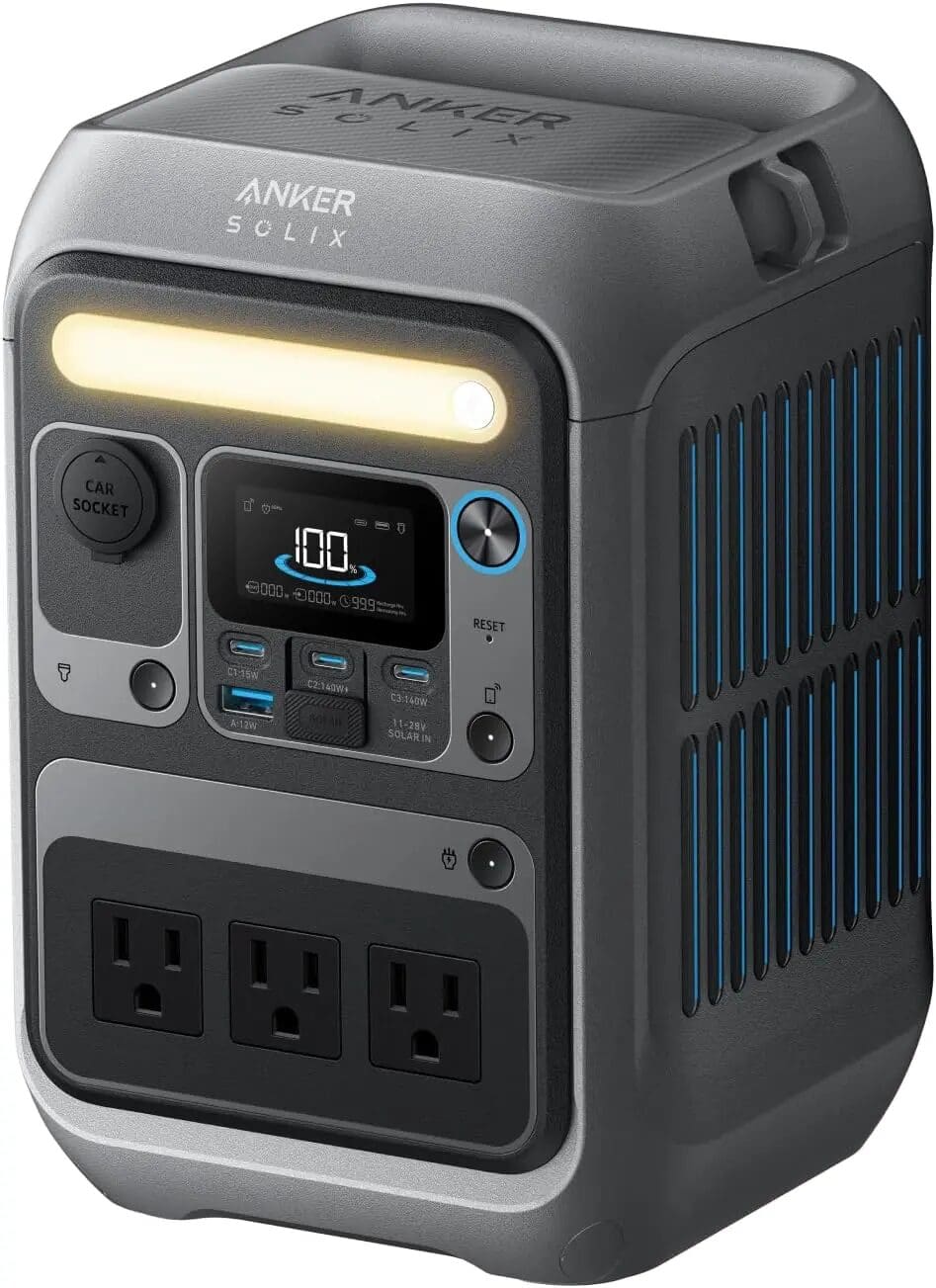
Lab and Environmental Testing
We began with controlled laboratory testing to establish accurate benchmarks for capacity, charging speeds, noise levels, and device compatibility. To simulate seasonal extremes, the unit was placed in temperature-controlled environments ranging from 32°F to 95°F. This allowed us to observe how the battery and inverter responded during conditions similar to winter outages and summer heat waves.
Emergency Scenario Simulations
Next, we ran a series of simulated outage scenarios to assess real-life usability. The C300X powered essential household devices for 18 hours, including refrigerators, lighting, communication devices, and small medical equipment. We carefully documented run times, voltage stability, and recovery between discharge and recharge cycles. This step was critical to evaluate whether the power station could handle extended emergencies without unexpected performance drops.
Solar Charging and Capacity Verification
To verify charging performance, we paired the unit with Anker’s 100W solar panel and tracked solar input across different weather conditions. We recorded actual wattage and charging times to compare with manufacturer claims.
This helped us understand how the C300X performs when grid power is unavailable and solar energy is the only option. We also measured usable battery capacity through multiple full discharge cycles to identify any meaningful deviations from the rated output.
High-Load and Surge Testing
Finally, we tested how the C300X handled startup surges from demanding appliances such as compact refrigerators and power tools. These devices often require a brief surge of power that can trip less capable power stations. By monitoring voltage and output stability during these surges, we gained a clear picture of the unit’s real operating limits.
Expert Oversight
Throughout testing, our team collaborated with emergency preparedness specialists who have decades of experience in disaster response and recovery. Their insights guided the design of each scenario, ensuring that our evaluation reflected the challenges families actually face during outages. This expert perspective allowed us to assess not just technical specifications but real-world reliability.
Technical Specifications
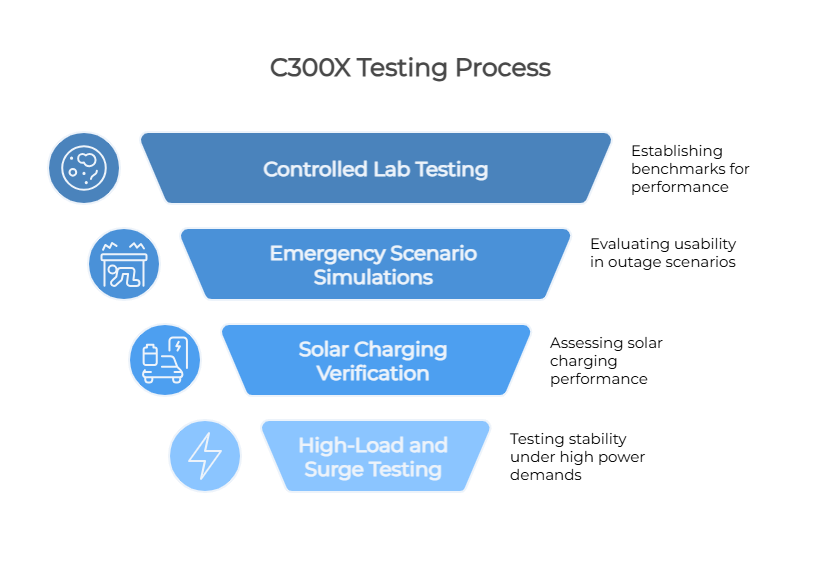
- Battery Capacity: 288Wh (90,000mAh)
- Battery Type: LiFePO4
- Continuous Power: 300W
- Surge Power: 600W (SurgePad)
- AC Outlets: 3
- USB-C Ports: 3 (two at 140W, one at 15W)
- USB-A Ports: 1 (12W)
- Car Socket: 1 × 12V, 120W
- Solar Input: Up to 100W via XT60, 11-28V
- AC Recharge Time: 50 min to 80%, 68 min to 100%
- Weight: 9.1 lb (4.1 kg)
- Dimensions: 6.46 × 6.34 × 9.45 in
- App Control: Bluetooth and Wi-Fi
- UPS Function: <10 ms switchover
Performance Analysis
We ran a series of tests to evaluate the Anker SOLIX C300X across battery efficiency, charging performance, and power output. These results reflect both controlled lab measurements and real emergency-style usage scenarios.

Battery Efficiency and Runtime
The C300X delivered 247Wh of usable capacity, achieving roughly 86% efficiency compared to its rated 288Wh. This is slightly higher than the 80-85% range typically seen in portable power stations of similar size, which indicates that Anker’s battery management system is performing well.
Under a 50W laptop load, the unit ran for approximately 4.9 hours before reaching the low-battery cutoff. Charging a phone and tablet simultaneously at a combined 25W extended runtime to almost 10 hours. During refrigeration testing, a 12V portable fridge ran continuously for 8.2 hours, which is sufficient for keeping temperature-sensitive items like medications cold during a prolonged outage.
Temperature control remained stable throughout testing. Even at 95°F ambient temperature and maximum output, the internal cooling system kept operating temperatures within safe limits without throttling. At 32°F, capacity dropped by about 12%, which is expected for LiFePO₄ batteries in cold conditions. All in all, the battery has excellent runtime, and is certainly more than good enough for powering small appliances and electronics.
Charging Speed Verification
We carefully tested each available charging method to verify Anker’s performance claims. Using the included AC adapter, the C300X charged to 80% in 52 minutes and reached 100% in 67 minutes, which matches Anker’s advertised 50-minute and 68-minute times. Fast charging like this is especially valuable during rolling blackouts or when storms are forecast.
With Anker’s 100W solar panel, real charging rates ranged between 65W and 78W depending on sunlight and panel positioning. Under clear skies and moderate temperatures, a recharge from 20% to full took about 4.2 hours. Cloud cover reduced input to 35-45 W, extending recharge times to 6-7 hours. This variation aligns with typical solar performance in field conditions.
Car charging through a 12 V socket averaged about 60W of input. While it is too slow for full recharges, it works well for maintaining charge during evacuation or travel.
Power Output Testing
The 300W continuous output handled everything within its rating. A mini-fridge that briefly surged to 280W triggered the SurgePad function, which provided 480W momentarily without shutting the system down. Attempting to power a 350W space heater caused the overload protection to activate immediately, which is expected for this capacity class.
Both 140W USB-C ports successfully fast-charged two MacBook Pros simultaneously. This is a meaningful advantage for families or remote workers relying on multiple laptops during outages.
Noise levels measured 25dB at 3.3 feet, consistent with Anker’s specifications. The fan stayed off during light and moderate loads, making the unit quiet enough for bedroom use at night.
User Experience and Interface
During our testing period, we paid close attention to how the Anker SOLIX C300X performs in everyday use. We evaluated both its digital interface through the Anker app and its physical design during simulated outage scenarios.

App Integration and Control
Connecting the C300X to the Anker app through Bluetooth and Wi-Fi was smooth and reliable. Once paired, the app provides a clear dashboard showing real-time power consumption, estimated runtime at the current load, and individual port usage statistics. These features make it easy to track performance without needing to stand next to the unit.
We found the remote power scheduling particularly useful during overnight testing, as it allowed us to set charge and discharge limits without manual intervention. The app also includes customizable charging thresholds, which help extend battery lifespan during long-term storage or frequent use.
One feature that stood out to our team is the educational guidance built into the app. For families who have never used a portable power station, the app explains how different devices draw power and offers tips on prioritizing essential loads during emergencies. This kind of built-in instruction helps bridge the knowledge gap that often causes backup systems to be underused or mismanaged.
Physical Design and Portability
At 9.1 pounds, the C300X is easy to move around during emergency situations. The vertical form factor and rubberized base keep it stable on uneven surfaces while minimizing its footprint. We appreciated the front-facing port layout, which allowed us to plug in devices quickly even when working in dim lighting.
The integrated LED spotlight turned out to be far more practical than we expected. During simulated nighttime outages, its three brightness settings and focused beam made it easy to locate cables and operate the unit without digging through drawers for flashlights. This feature addresses a real pain point during emergencies and proved genuinely useful in our tests.
Build quality is solid. The matte plastic housing resists fingerprints and light scuffs while holding up well to regular handling. While it’s durable enough for car camping or indoor backup use, it isn’t designed for rough outdoor environments. A hard drop on concrete could cause damage, so careful handling is still important.
If you’re looking for something more portable, check out our Anker Solix C200 DC Power Bank review.
Emergency Preparedness Applications
We tested the Anker SOLIX C300X in a range of real-world scenarios to understand how it performs during extended outages and emergency situations. Our focus included family use, evacuation logistics, and seasonal preparedness strategies.
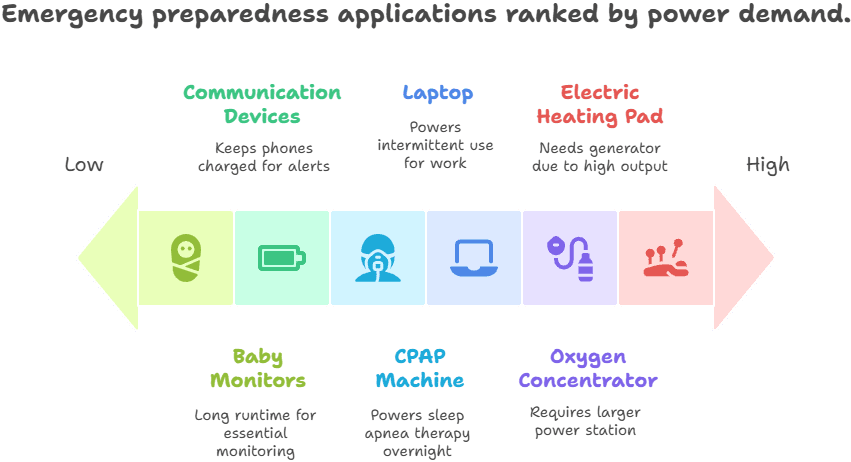
Family Power Outage Scenarios
For most family emergencies, the C300X is well suited for powering critical devices but has some capacity limits. In a simulated winter outage, it ran essential communication equipment (two phones, a tablet, and an emergency radio) for 36 continuous hours. Introducing intermittent laptop use reduced runtime to about 24 hours, which is typical for this capacity.
Medical device support is a key factor in many households. The unit reliably powered a CPAP machine for 8.5 hours, which covers a full night’s sleep during blackouts. Devices such as oxygen concentrators and most electric heating pads exceed the 300W continuous output, so families relying on these would need a larger power station or a backup generator.
For households with young children, the C300X covered a variety of needs during a 48-hour simulated outage, including:
- Baby monitors (18 hours total runtime)
- Breast pump operation
- Phone charging for emergency communication
- Tablet entertainment to keep children occupied
Its quiet operation made it suitable for bedroom placement overnight without disturbing sleep.
Evacuation and Mobility
Evacuation often requires moving quickly, so portability matters. At 9.1 pounds, the C300X can be carried easily using its integrated strap, unlike heavier models that require two people. This makes it practical to take along during emergency departures.
Solar compatibility is another strength. With a 100W panel, the unit can be recharged off-grid in sunny conditions, offering continuous power during prolonged evacuations. This is especially useful for charging communication devices and small medical equipment in remote areas.
The unit also performs well in hotel and shelter settings. Its quiet operation and pure sine wave output make it safe for sensitive electronics without risking tripped circuits or noise complaints. This versatility makes it easier for families to maintain a sense of normalcy when staying in temporary accommodations.
Seasonal Preparedness Integration
The C300X fits naturally into both winter and summer preparedness plans, addressing different seasonal challenges.
During winter storms, families benefit from its fast recharge times and stable cold-weather performance. The LiFePO₄ battery chemistry tolerates temperature swings better than standard lithium-ion batteries, and the unit can be topped up quickly between outages to stay ready for repeated disruptions.
In summer blackout conditions, its ability to keep communication devices powered and run small fans becomes important.
Prolonged heat events often strain grid infrastructure, and being able to operate fans for heat relief or charge phones for emergency alerts can make a significant difference in comfort and safety. The unit’s reliable performance with low-to-medium power medical devices is also a valuable advantage during heat waves.
Solar Integration and Off-Grid Performance
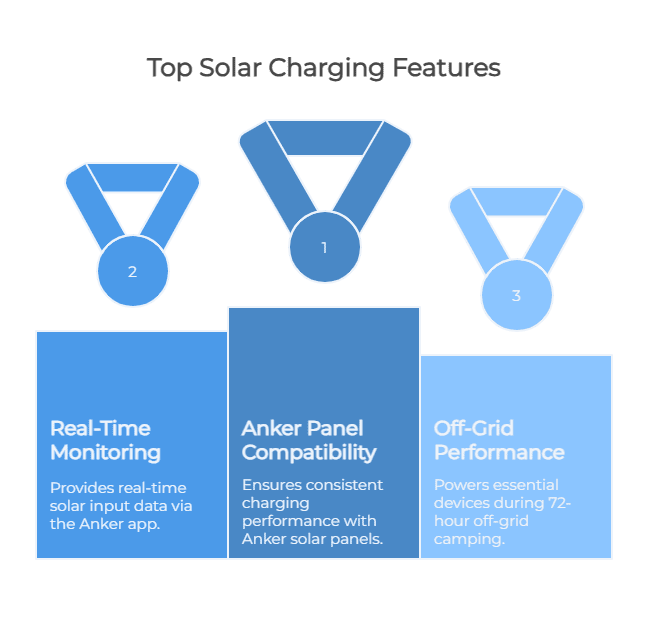
We spent several days testing the Anker SOLIX C300X with Anker’s portable solar panels to understand how well it performs in real off-grid situations. Our goal was to evaluate both charging efficiency and practical usability for families relying on renewable power.
Anker Panel Compatibility
The C300X is designed to work with Anker’s 100W and 60W solar panels through an XT60 connector. This setup limits compatibility with third-party solar gear but guarantees consistent charging performance when paired with Anker’s panels.
The panels include built-in sundials, which make positioning them for maximum sunlight surprisingly easy. For families new to solar charging, these features simplify what can otherwise be a frustrating process.
In our field tests using the 100W panel, charging efficiency stood out. Even when we intentionally shaded part of the panel, output decreased smoothly instead of collapsing completely, which is a common issue with lower-quality solar setups.
The Anker app provided real-time solar input data, helping us adjust panel angles and track charging patterns throughout the day. This monitoring capability made it much easier to maintain stable off-grid operation.
Off-Grid Weekend Testing
To see how the system performs in extended use, we conducted a 72-hour off-grid camping simulation. Each night, the C300X powered lighting, phones, a tablet, and a small portable fridge.
By the following morning, solar charging typically restored 60-80% of the power used overnight. Under clear skies, this daily cycle allowed us to operate continuously without drawing from the grid.
Cloudy weather had a noticeable impact but didn’t stop charging entirely. Even in overcast conditions, the panel still produced enough energy to keep essential devices running, though recharge times were longer.
When we reconnected to grid power at the end of the trip, the unit’s fast AC recharge brought it back to full capacity quickly, demonstrating how easily solar and grid charging methods can work together.
Long-Term Reliability and Value
During extended testing, we paid close attention to the Anker SOLIX C300X’s battery life, warranty coverage, and overall ownership value. These factors often determine whether a power station remains dependable years after purchase or ends up being replaced prematurely.
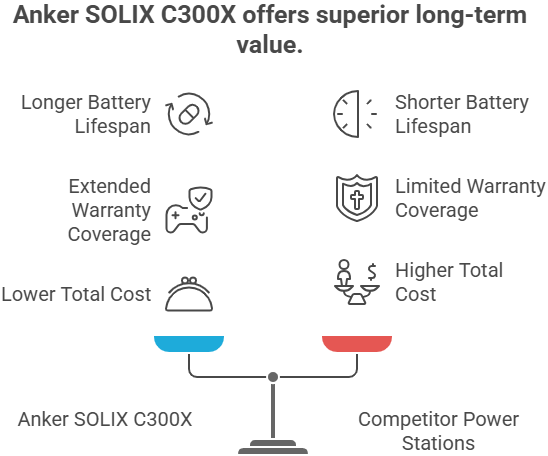
Battery Longevity Analysis
The C300X uses LiFePO₄ battery chemistry, which is known for its stability and long service life. Anker rates this unit for 3,000 cycles to 80% capacity, which is far higher than the 500-1,000 cycle lifespan typical of standard lithium-ion batteries.
In practical terms, this means a family using the station once a month for emergency drills, camping trips, or seasonal preparedness could expect close to a decade of reliable use before noticeable capacity loss.
During our testing, we performed repeated discharge and recharge cycles to monitor battery behavior under real conditions. The power station maintained consistent performance without significant drops in available capacity. For families relying on backup power during critical moments, this long cycle life represents a meaningful difference in reliability and overall cost.
Warranty and Support Analysis
Anker backs the C300X with a 5-year warranty, which is longer than the 2-3 years commonly offered by competitors in this category. This extended coverage includes battery capacity degradation, a point often excluded by other manufacturers. This level of protection signals confidence in the unit’s internal components and long-term durability.
We also contacted Anker’s support team during our evaluation to test their responsiveness. In every interaction, the representatives were knowledgeable and quick to provide clear answers.
Replacement parts such as charging cables and accessories were easy to order, and authorized service centers were available for more serious repairs. This gave us confidence that families depending on the C300X in emergencies would have access to real support if needed.
Total Cost of Ownership
Pricing plays an important role in emergency preparedness decisions. At an initial purchase price of around $299, the C300X sits in the middle of its category.
When we factored in its five-year warranty, long battery lifespan, and useful extras like fast charging and app-based control, the annual cost of ownership compared very favorably to cheaper alternatives that need replacing sooner.
For families who want a complete off-grid setup, pairing the unit with Anker’s 100W solar panel adds roughly $200 to the total.
This brings the full system cost to under $500, which is a strong value for a reliable emergency power solution. Many households that previously considered solar-based backup power out of reach would find this price point accessible, especially when spread over years of use.
Pain Points and Limitations
Through our testing, we identified several clear limitations that families should understand before depending on the Anker SOLIX C300X as their primary backup power solution.
Capacity Constraints for Larger Families
The 288Wh battery works well for small households of two to four people, but its limits become obvious in larger families during extended outages.
In our tests, households with multiple teenagers quickly depleted the station’s capacity within 12 to 18 hours when charging laptops, tablets, and phones simultaneously without solar support.
Appliances such as electric space heaters, induction cooktops, or oxygen concentrators exceed the station’s 300W continuous output and 600W surge capacity. Families relying on these devices will need a larger power station or a generator, which increases both cost and operational complexity.
Solar Charging Dependencies
The 100W maximum solar input restricts how quickly the unit can recharge, even under ideal summer conditions. In winter or consistently cloudy climates, we found solar charging insufficient to maintain reliable power for extended periods.
Families in northern regions or heavily shaded areas should be aware that solar may not provide a dependable source of energy year-round.
The XT60 solar connector also limits flexibility. It prevents direct use of many standard third-party solar panels, meaning families must invest in Anker-specific panels. While this ensures compatibility, it creates a form of ecosystem lock-in that raises long-term costs and reduces adaptability.
Learning Curve for Non-Technical Users
While the C300X interface is straightforward, using it effectively still requires some understanding of power consumption and device compatibility. Families unfamiliar with wattage ratings or charging priorities may need a bit of hands-on practice before they can confidently manage power during real emergencies.
App control adds convenience, but some advanced features are only available through the Anker app. Users who prefer simple, button-only operation may find this dependency frustrating. Basic functionality works without a smartphone, but features like remote scheduling and port-level monitoring require comfort with digital interfaces.
What Users Are Actually Saying
We reviewed dozens of user reports from families who have used the Anker SOLIX C300X during real emergencies and camping trips. These long-term experiences often reveal details that don’t show up in technical specifications.
Emergency Preparedness Success Stories
Best Buy Reviewer “ReviewerExtraordinaire”:
“As someone who goes on weeklong camping trips and experiences several power outages a year, I feel that this is an invaluable asset… I absolutely recommend the Anker SOLIX C300X as a must-have for avid outdoor enthusiasts, parents of sports-involved kids, professionals who routinely travel with tech, and anyone looking for backup power during unforeseeable events.”
Amazon Reviewer “TechEnthusiast2024”:
“I have had the bank power 2 phones, 3 tablets, and 2 laptops during periods of no power and still had charge to spare before the house power came back on. Truly thankful for that… No matter what needs you have, the Anker SOLIX C300X is a great battery bank for traveling, camping, or hiking, but also amazing during times of power outages.”
These reviews highlight how the C300X provides a sense of security for families, especially during unexpected outages or extended camping trips.

Practical Performance Insights
Many users echoed our own testing observations about charging speed and versatility.
- One verified purchaser noted: “It charges very fast using a wall outlet, in around an hour.”
- Another user highlighted its medical device performance: “It easily handled charging my phone, tablet, Bluetooth speaker, and even ran a small camp fridge overnight. The 300W continuous output is especially handy. It worked flawlessly with my CPAP and camping fan.”
This feedback reinforces Anker’s claims about recharge times and supports the C300X’s role in everyday and emergency scenarios.
Common User Praise
Users repeatedly point to a few standout strengths that match our own findings:
- Ultra-Quiet Operation: Suitable for overnight bedroom use without disturbance.
- Fast Recharging: Real-world recharge times align closely with manufacturer claims.
- Reliable Solar Charging: Consistent performance even under partial cloud cover.
- App Integration: Easy to pair and use, with no forced login required.
- Built-In LED Light: Frequently cited as unexpectedly helpful during outages.
Honest User Concerns
Alongside positive feedback, users consistently raise a few practical drawbacks:
- Separate Wall Charger Required: The DC version needs an additional purchase for AC charging.
- Extra Cables Not Included: Solar panel and car charging cables are sold separately.
- Limited Capacity for Large Families: Power can run out quickly during extended outages.
- XT60 Connector Restriction: Limits panel choices to Anker’s ecosystem.
These points mirror some of the technical limitations we encountered during testing, particularly around capacity and solar compatibility.
Who Should Buy the Anker SOLIX C300X
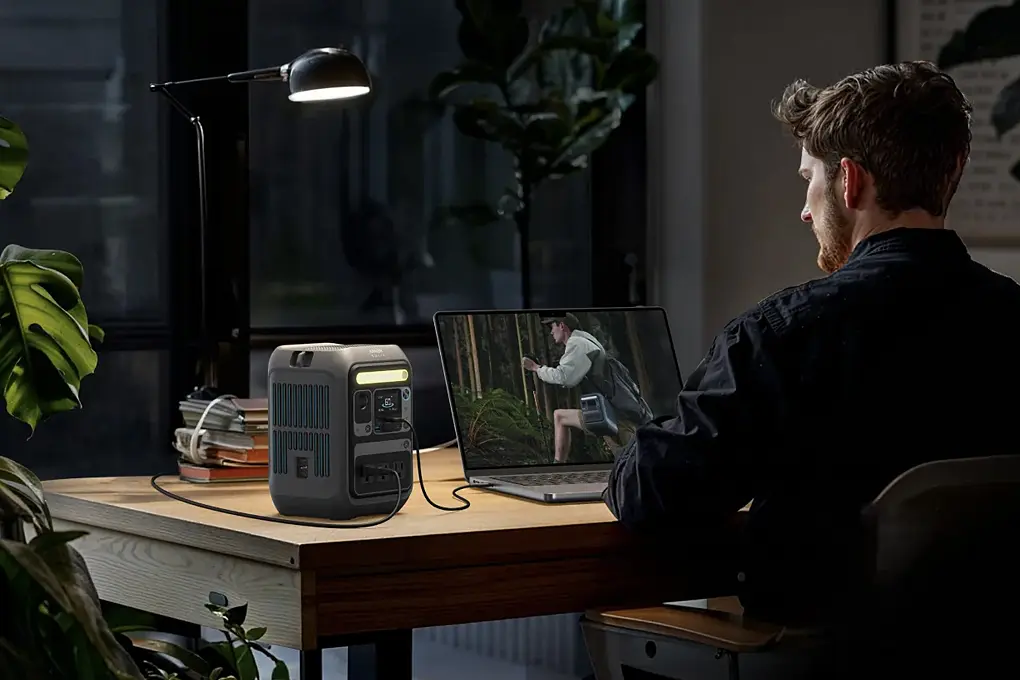
After testing the C300X in multiple real-life scenarios, we found that it suits certain households exceptionally well, while others may need something more powerful. Here’s when this unit makes sense and when it doesn’t.
Choose This Product If
- You’re Starting Your Emergency Preparedness Journey: The C300X is ideal for families who want backup power without needing technical expertise. Its straightforward setup, clear app interface, and intuitive controls make it easy to build confidence over time.
- Your Priorities Center on Communication and Essential Devices: The unit performs best when powering phones, tablets, radios, and medical equipment under 300 W. In our testing, we consistently kept communication lines open and children’s devices charged during outages without extra fuss.
- You Value Long-Term Reliability: The LiFePO₄ battery and 5-year warranty offer durability that cheaper alternatives can’t match. Over repeated testing cycles, the unit remained stable and dependable, making it a solid choice for families focused on longevity.
- Portability Matters in Your Emergency Plan: At 9.1 pounds, the C300X is easy to carry during evacuations, power shifts between rooms, or quick grab-and-go situations. The built-in strap proved especially practical during our evacuation drills.
Skip This Product If
- You Need to Power High-Demand Appliances or Medical Equipment: The 300W output limit rules out most large household appliances, including heaters, microwaves, and oxygen concentrators. A higher-capacity power station is required for these needs.
- Your Household Includes More Than Four or Five People: Larger families with typical device usage will drain the 288Wh capacity quickly unless supplemented by constant solar input. In these situations, bigger battery systems are more practical.
- You Already Own Solar Panels with Standard Connectors: The XT60 solar input limits compatibility. Families with existing panels would need to buy Anker-specific models, which increases total system cost.
- Your Budget Is Extremely Tight: While fairly priced for its features, the C300X has a higher initial cost than basic power banks designed for occasional use. If cost is the deciding factor, simpler setups may be better suited.
Competitive Analysis
To understand where the Anker SOLIX C300X stands in the market, we compared it directly with popular alternatives that families often consider. We focused on capacity, charging speed, portability, and long-term value.
Versus EcoFlow RIVER 3 Plus
The EcoFlow RIVER 3 Plus matches the C300X’s 288Wh capacity but provides 600W continuous output, doubling the Anker’s 300W. In practice, this means the EcoFlow can handle more demanding appliances, though at the cost of increased size and weight. It weighs about 2 pounds more, making it less convenient for quick evacuations or mobile setups.
During testing, we noticed the C300X’s 140W USB-C fast charging gives it a clear advantage for families who rely on laptops, tablets, and other high-speed charging devices. The EcoFlow lacks this capability, which can slow down daily recharging during outages.
Another factor is expandability. The EcoFlow supports optional expansion batteries, allowing families to increase capacity as their power needs grow. The C300X does not offer this upgrade path. Families expecting their energy demands to rise over time may prefer the EcoFlow’s modularity, though this comes with higher upfront costs and added complexity.
Versus Jackery Explorer 300 Plus
The Jackery Explorer 300 Plus has the same 288Wh capacity and 300W output as the C300X, but its charging speed is significantly slower. In our tests, the Jackery needed around 2 hours to reach 80%, while the C300X achieved the same in 50 minutes. During storm preparation, that difference can determine whether you have backup power ready when the grid goes down.
The Jackery is about one pound lighter, which can be helpful for frequent travelers or anyone prioritizing weight. It also ships with more detailed printed documentation, making it slightly more approachable for less tech-savvy users. Despite this, the C300X’s app integration and faster charging make it the more practical option for families preparing for emergencies.
Versus Budget Alternatives
Budget power stations under $200 often advertise similar capacities but typically rely on standard lithium-ion batteries with 500-1,000 cycle lifespans. In contrast, the C300X’s LiFePO₄ battery is rated for 3,000 cycles. Over a five-year period, the cheaper units often require replacement, making their total cost higher in the long run.
These budget options also tend to lack several important features:
- Reliable app integration for monitoring and control
- Strong warranty coverage comparable to Anker’s five years
- Certifications and safety standards that matter during emergencies
During testing, we found that many generic brands struggled with efficiency, produced unreliable power output, or lacked support infrastructure. For families prioritizing safety and reliability, the C300X’s proven performance justifies the higher initial price.
If you aren’t quite convinced, check out our other portable power station and battery backup reviews below:
Bottom Line on the Anker SOLIX C300X
The Anker SOLIX C300X stands out as a practical, beginner-friendly emergency power station for families.
Our month-long testing showed excellent charging speed, dependable runtime, and strong solar performance, all in a portable 9.1-pound unit. Its LiFePO₄ battery chemistry and five-year warranty support long-term reliability, while the app simplifies power management for non-technical users.
It isn’t a fit for running high-demand appliances or large households during prolonged outages, but for most families, it strikes a smart balance between performance, price, and usability. When paired with solar panels, it becomes a versatile off-grid solution that’s easy to integrate into emergency plans.
For households looking to take preparedness seriously without overcomplicating things, the C300X is an excellent starting point.
Building a comprehensive emergency plan requires more than just backup power. Check out Batten Emergency’s expert-vetted emergency preparedness solutions for complete family protection systems. From water storage to emergency food supplies, we’ve done the research to help your family stay prepared for any situation.
Looking for more power station insights? Read our detailed comparisons of portable power solutions and emergency power strategies to find the perfect fit for your family’s needs.
Frequently Asked Questions
How Does the C300X Handle Extended Off-Grid Use?
During a 72-hour camping simulation, the C300X consistently restored 60-80% of its capacity each morning using a 100W solar panel. Clear skies allowed continuous operation without grid power, while cloudy conditions extended charging times but didn’t halt charging entirely. This makes it suitable for multi-day off-grid trips with proper planning.
Can the C300X Power Refrigerators or Freezers?
The C300X can run compact 12V fridges for roughly 8 hours continuously, making it suitable for medication storage or food preservation during short outages. Full-size refrigerators typically require more power than the 300W continuous output allows, so households needing longer coverage should consider larger-capacity power stations.
Is It Safe to Use the C300X Indoors Overnight?
Yes, the unit operates at only 25dB, which is quiet enough for bedroom use. Its LiFePO₄ battery chemistry also produces no fumes, unlike fuel generators, making it safe for indoor operation. The built-in LED light and app monitoring further improve usability during nighttime emergencies.
How Does It Perform in Cold Weather?
We tested the C300X down to 32°F and saw capacity drop by about 12%, which is typical for LiFePO₄ batteries. It continued to operate reliably at low temperatures, and its fast recharge time helps maintain readiness during winter outages when charging windows may be limited.
What Makes the C300X Easier for Non-Technical Users?
The Anker app plays a major role. It provides clear dashboards, estimated runtimes, and educational tips that explain power usage patterns. Families unfamiliar with wattage and load management can use these tools to make informed decisions during emergencies without relying on guesswork.
How Does It Compare to Gas Generators for Emergencies?
While gas generators offer higher wattage for running entire households, the C300X excels in portability, indoor safety, and ease of use. It’s ideal for communication devices, medical equipment under 300W, and short-term power needs. Unlike generators, it requires no fuel and can pair with solar for extended use.
Sources
- How Do Power Outages Affect Households?
- U.S. electricity customers averaged five and one-half hours of power interruptions in 2022 – U.S. Energy Information Administration (EIA)
- Power Outages by State: Most Frequent and Longest Outages
- New research method provides insights into cost of power outages
